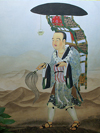|
Xuanzang (玄奘)
Chinese. Name a Buddhist monk (fig.), who was born in present-day Henan Province as Chen I (陈祎) in 602 AD. He was a scholar, who traveled to
India on a
pilgrimage, in order to obtain a copy
of the
sutras, which he translated into Chinese (fig.). In addition, he described the interaction between
China and India in the early Tang Dynasty. His travels are recorded in the
Xiyouji, i.e. the chronicle of the ‘Journey to the West’ (fig.). As a boy, he was already interested in religious books and classical literature, and at the age of thirteen he became a novice in the city of Luoyang (fig.), which he fled after the fall of the Sui Dynasty in 618. He went to Chengdu in Sichuan Prvince, where he was ordained as a monk at he age of 20. He later traveled throughout China in search of sacred books of
Buddhism, and eventually came to what today is Xi'an (fig.). From here, he set out on his 17-year long journey to India and back, along the overland northern trade route
of the so-called
Silk Road. On his return to China, he retired to a monastery and devoted the remainder of his life to the translation of the more than 600 texts that he had brought with him from India. He died in 664 AD. A large part of the Big Wild Goose Pagoda (fig.) in Xi'an is devoted to Xuanzang (fig.) and his work. He is also known by the
Sanskrit name
Tripitaka (fig.), which is an equivalent for the Chinese name Sanzang (fig.), which was a traditional honorific name for any Buddhist monk during the Tang Dynasty.
回






|

